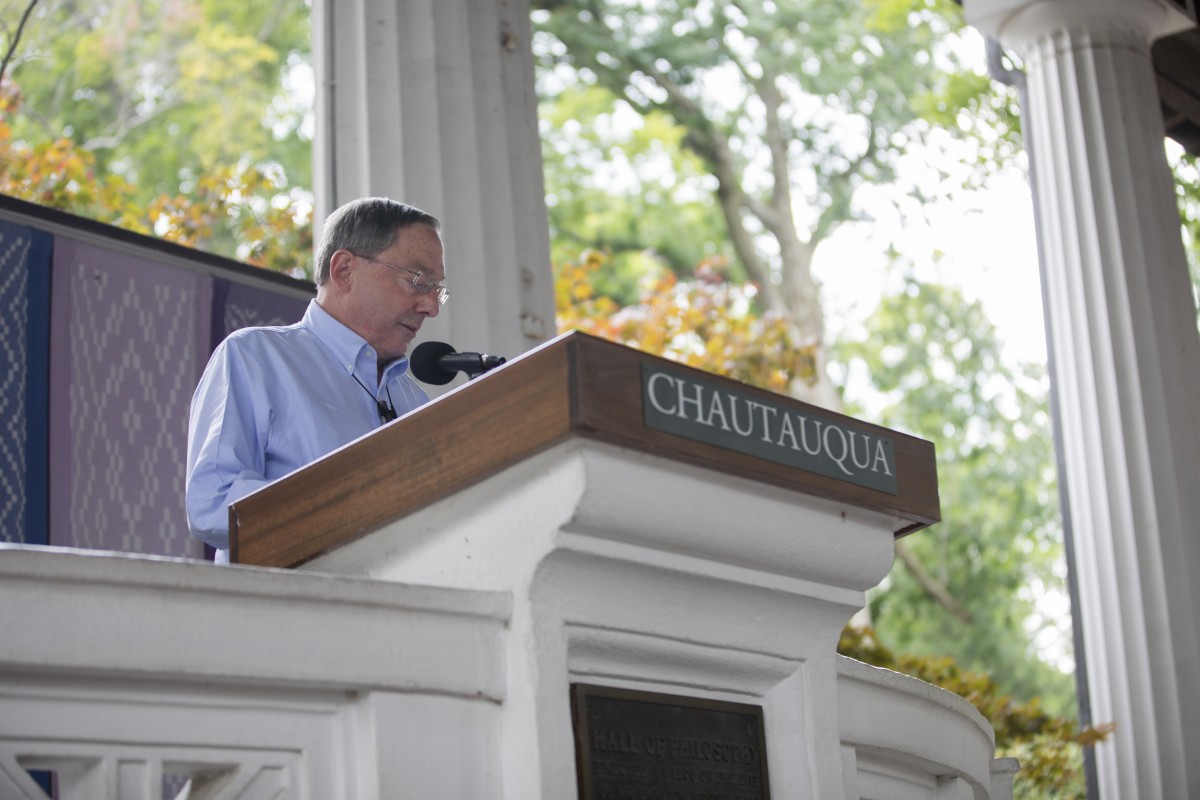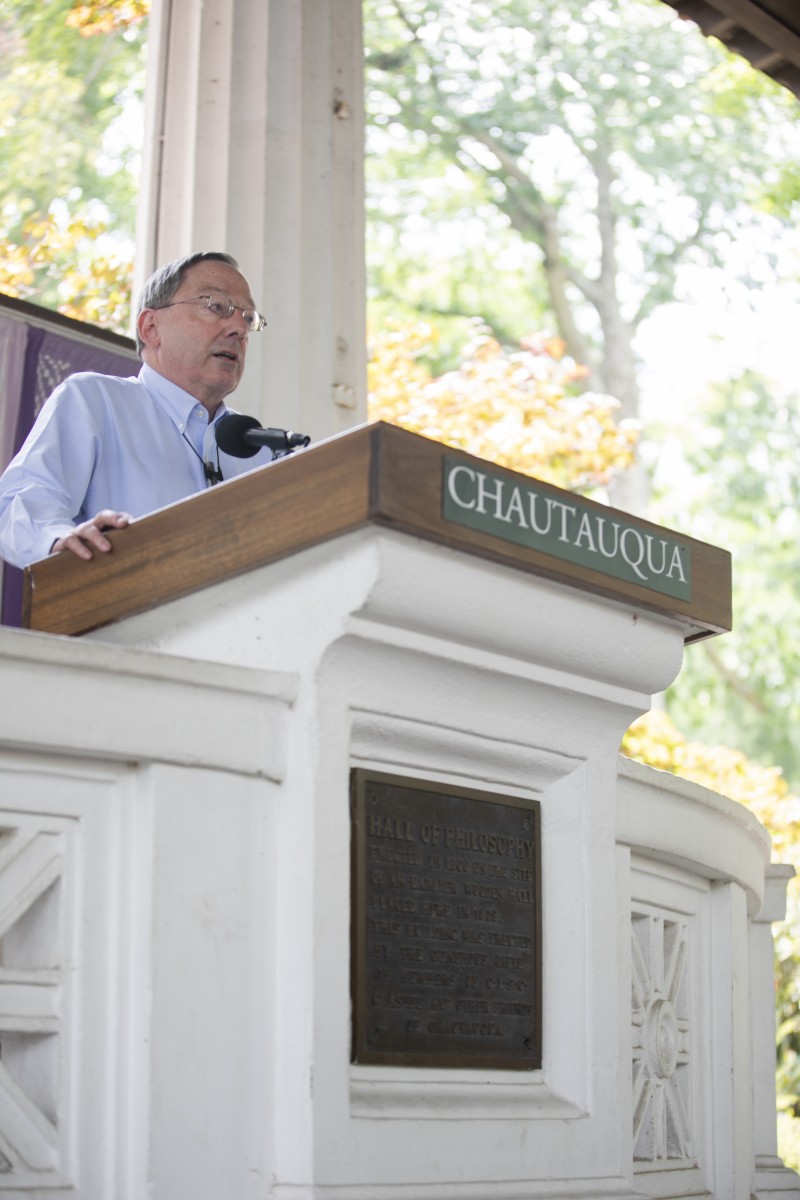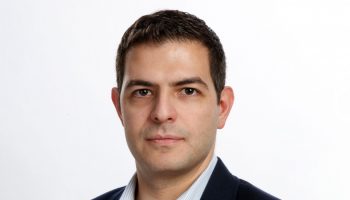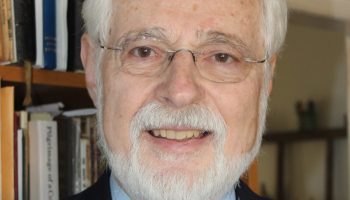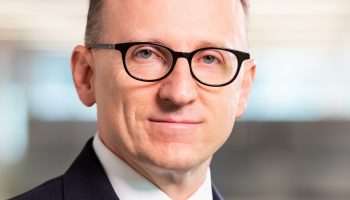Even before the First Amendment was ratified, Douglas Laycock said practicing religious freedom has never been a piece of cake.
At 2 p.m. Monday, August 6, in the Hall of Philosophy, Laycock, the Robert E. Scott Distinguished Professor of Law at the University of Virginia School of Law, gave his lecture, “Free Exercise of Religion – from Martin Luther to Masterpiece Cakeshop,” as part of Week Seven’s interfaith theme, “Let Them Eat Cake? Defining the Future of Religious Freedom in the U.S.”
The prelude to America’s “experiment with religion liberty” began with Martin Luther’s Protestant Reformation, Laycock said.
“Earlier reformers had been oppressed, but Luther had the enormous advantage of the printing press and he spread alleged heresy on a continental scale,” he said.
Laycock said although Protestants and Catholics were fighting for religious liberty, neither group was ready for it.
“They both assumed that they should enforce their faith wherever the government would cooperate,” he said. “Never forget that it was government, not churches, that had the power to punish and to execute. That is why our constitution protects religion from government, not the other way around.”
However, it turned out many governments were willing to persecute. The resulting persecutions, or “wars on religion,” consumed Europe for the next 200 years, Laycock said.
“Of course, the English experience is most salient in America,” he said. “England was irretrievably Protestant by the end of Elizabeth’s reign in 1603, but the persecutions continued, and religious warfare broke out in intervals. Anglican Puritans’ civil war in the 1640s was a revolution that overthrew a Catholic king in 1688, and a final climactic battle between Protestants’ and Catholics’ claims to the throne in 1746 is within the living memory of the men who wrote the Constitution.”
All of this human suffering led “sensible people” to question the premise: Why not let each individual determine a religious stance for his or herself?
First came the idea of tolerance.
“The state would still designate the true church and support it in various ways, but the state and the true church would tolerate dissenters,” Laycock said.
Religious equality was the second idea, Laycock said.
“Rather than one official church that tolerated all of the others, religious liberty would be a natural right,” Laycock said. “It would mean equal rights for every church and every believer and, eventually, every non-believer as well.”
The concept of religious liberty sparked debate among the American people.
“Defenders of the old regime offered multiple reasons for state control of religion, but all of the reasons had one thing in common: Religion is too important to be left to individuals,” Laycock said.
One of most common reasons for giving the state control of religion was to “save souls.”
“If there is one true faith whose believers will be saved, and many false teachings whose believers will be damned, then heretics need to be forced into the true faith for their own good and also to protect the innocent that they might lead astray,” Laycock said.
Laycock said the argument of keeping the peace was secular and the argument of saving souls was more theological and with both, each individual’s salvation was at stake.
“That turned the old view on its head,” he said. “Religion was far too important to be left to government.”
By the early 18th century, toleration had come — even to New England. First, government officials exempted dissenters from attending the established church. Eventually, they declared that any Christian denomination can hold its own worship service and by the 1720s, the United States and New England were enacting regulatory exemptions for religious minorities.
“First, they exempted Quakers and Baptists from paying a church tax, then they exempted Quakers from swearing oaths, and in 1757, during the French and Indian War, Massachusetts finally addressed the most difficult issue of all and exempted Quakers from serving in the militia,” Laycock said.
During the American Revolution, every state wrote a constitution; the federal constitution followed in 1787.
“Church and state was a major issue in those constitutional conventions, but the fight was over how to finance the church,” Laycock said. Including religion in the state and federal constitutions led to the most fundamental disagreement, Laycock said.
On one side, Americans declared that the constitutional right to religion must include the right to be exempt from laws that interfere with one’s religious beliefs unless the government has a strong reason for refusing an exemption.
The other side of the debate said that exemptions for Quakers, Jewish people and dissenters who refused to pay the church tax were all enacted by legislatures, Laycock said.
“(The legislatures) addressed specific problems,” Laycock said. “They tell us nothing about what rights were made judicially enforceable, and they tell us nothing about any claim to religious exemptions for any new law or new practice that might arise in the future.”
The issue of church and state first reached the Supreme Court in 1878 with Reynolds v. United States, the prosecution of a polygamous Mormon leader.
“The opinion is embarrassing to read today,” Laycock said. “The court said polygamy wasn’t even really a religious practice, and it had been a practice of Asian and African people, but never Europeans.”
Laycock said the court drew a definitive line between belief and action.
“It said you can believe any religion you want, but you have no right to practice it if the legislature says no,” Laycock said.
But the court’s protection of belief was short-lived. In 1890, the Supreme Court upheld a test oath that prevented Mormons from voting in Davis v. Beason. The oath covered not just polygamy, but also “speech, church membership and mere belief.”
“Congress revoked the church’s corporate charter and seized all of its property besides actual places of worship,” Laycock said. “Shortly after, the Mormon Church banned any plural marriages.”
However, in 1892, the Supreme Court had ruled on a case about a Presbyterian church in Louisville, Kentucky. The court declared that civil courts must defer to the highest authority in the denomination.
“That decision has given rise to a principle that churches have the right to control their own internal affairs,” Laycock said.
He said that principle is why the Supreme Court unanimously decided in 2012 that employees in positions of religious leadership can’t sue their churches for alleged discrimination and why churches can’t be required to perform weddings, except in accordance with their own rules.
The debate around the free exercise of religion remained an issue of personal belief until it became a “culture war issue” in the late 1990s, Laycock said.
“Gay rights groups and civil rights groups demanded a total carveout for all civil rights claims, and of course, the sponsors couldn’t give them that,” he said. “Secular civil liberty groups dropped out of the Coalition for the Free Exercise of Religion, and religious groups could not pass a bill without them.”
The most recent example of a culture-based case was the Masterpiece Cakeshop v. Colorado Civil Rights Commission.
“Masterpiece is among a handful of cases where conservative Christians in the wedding business refused to assist with a same-sex wedding and get sued under a state public accommodations law,” Laycock said.
Laycock said vendors, like the owner of Masterpiece Cakeshop, view marriage as an inherently religious relationship and therefore think of weddings as religious events, too.
“Their job is to make their part of the wedding the best and most memorable it can be,” he said. “(People who provide services for weddings) see themselves as promoting it, celebrating it, and they say they can’t do that.”
Over time, Laycock said cases like Masterpiece have been litigated under state constitutions in blue and purple states with statewide gay rights laws. However, the federal government took a much larger role in the Masterpiece Cakeshop case because Colorado had no previous ruling interpreting the state constitution’s free exercise clause.
The baker claimed that the cake decorations were works of art protected by the free speech clause.
“If you look at the pictures of those cakes, that’s not crazy, but it is an argument with no logical stopping points,” Laycock said. “If cake decorating is speech, then lots of businesses are speech.”
Laycock and a colleague filed a friend of the court brief for Masterpiece devoted to free exercise.
“We said this (wedding) is a religious event; only small business should be exempted and only with things directly connected to the wedding,” he said. “Almost no one took us seriously except for seven justices on the Supreme Court.”
In 2015, William Jack, a Christian activist, tested the flip side of the Masterpiece argument. He went to three different bakers requesting cakes with religious messages hostile to same-sex marriage. Each baker refused to make the cake, and they were charged with religious discrimination, but the charges were dismissed.
“The same Colorado law that prohibits sexual orientation discrimination prohibits discrimination on the basis of any religious belief or practice,” Laycock said.
Laycock said in its decision of the Masterpiece Cakeshop case, the Supreme Court proved that the reason for protecting free exercise now is the same as it was 200 years ago: to reduce human suffering and preserve social peace.
“Religious liberty is one of America’s great contributions to the world, and we should not let it slip away either in legal wrangling or in a bitter culture war,” Laycock said.


